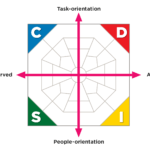The goal of DISC Leadership training is to provide useful tools to better our skills as a leader. All leaders, regardless of their DISC profiles, can use these simple and effective steps to be more self-aware and lead more successfully.

DISC Leadership training and DISC profiles
There is no ideal leadership style. Rather than focusing on the ideal leader, use the tools in DISC Leadership training to recognize diversity of roles, situations and people to improve leadership skills. The most successful leaders are keenly self-aware and have the ability to adjust their leadership styles to meet the demands of diverse roles.
Different individuals and situations require different leadership DISC profiles. The DISC model describes the four-quadrant model of human behavior. Each quadrant is associated with a style D, I , S or C. Leaders possess a range of styles on the DISC Model. Each leadership style reflects the impact of the different DISC styles.
The Leadership DISC Report provides a map to improved interactions with others. By understanding the DISC styles, his or her own style, and how to read the styles of others, leaders can better adjust their own style to achieve goals. Hence, knowing one's DISC leadership style and recognizing the styles in others can lead to winning results.
4 steps to an effective DISC leadership training
Using a simple 4 step approach to DISC leadership training provides a practical approach to more effective leadership. The process is simple, yet powerful. Therefore, the 4 Steps can easily be put into practice after the leadership training. The Extended DISC Leadership report and support materials are built on this simple and highly effective training outline.
- Understanding the four main DISC styles.
- Identify one's own DISC leadership style and how others perceive you.
- Reading other people's styles to better understand them.
- Adjusting your communication style to achieve your goals.
Understanding the four main leadership DISC styles
D-style leadership profile
A D-style leader emphasizes a more authoritarian style of leadership. The D-style leader prefers to be in charge and in complete control. D-style leaders are also a highly focused style where the leader leads the followers. The D-style often applies pressure to quickly attain targeted, short-term goals. He or she will focus on speed and quick execution. The leader talks and the followers listen.
I-style leadership profile
An I-style leader is more informal and social. He or she focuses on creativity, positivity, enthusiasm, and energy. These are valued more than accuracy, tasks, or detailed rules by an I-style leader. Emphasis on personal relationships and leading as a friend. The I-style leader promotes competitiveness by inspiring others and not by using pressure.
S-style leadership profile
An S-style is a supportive leader who guides, teaches, and develops followers. An S-style leader focuses on loyalty, consensus, trust and sincerity. S-style leaders support their teams. They provide help and support and expect it in return. S-style leaders promote gradual progress while strongly focusing on shared long-term goals.
C-style leadership profile
A C-style leader focuses on quality, rules and compliance with little tolerance for mistakes. C-style leaders tend to maintain a distance from their teams. Hence, they are more likely to have less personal connections. The C-style leader focuses on data, facts and systems. C-style leaders prefer written communication to ensure everyone knows exactly what is expected.
Clearly, the most successful CEOs, presidents, and leaders come from all different DISC profiles. D-styles are decisive and not afraid to take control. I-styles are charismatic and promote ideas. S-styles pull up their sleeves and get things done while still maintaining the company's core values. C-styles focus on high quality and doing things correctly. Each leadership DISC style brings its own set of strengths and development areas.
Identifying one's own DISC leadership style
The Extended DISC Profiles clearly show a person's two DISC-styles. The Natural Style identifies who a person really is. This style remains fairly stable, but not rigid, over adult lifetime. Natural Style is the style that is the most comfortable. It requires the least amount of focus, energy and effort. It is also the behavioral style that others are most likely to observe in the person. In other words, it is one's “true style”.
Secondly, Adjusted Style identifies how one perceives a need to adjust DISC style to better suit the demands of the present work environment. As a result, this style depends on the setting and changes as the environment changes. Events such as a new position, a new boss, or a new job typically change one's “adjusted style”. Remember, the Adjusted Style is based on one's own perception. It does not mean it's what one should do, but shows what he or she feels the needs to do.
Reading other people's styles to better understand them
Just as each DISC leadership style brings strengths, each also has areas that also need to be constantly and consciously developed. D-styles need to consider others and know when to not take too many risks. I-styles need to stay organized and maintain focus on the end goals. S-styles need to take action and decide more quickly and think "outside the box." C-styles need to be less critical and not so hard on themselves. They should be more open and ready when things don't go as planned and they are faced with surprises.
Once leaders have identified their own styles, the next step is to identify the styles of others. Knowing the style of others allows one to make the most effective behavioral modifications. This is a skill that takes some practice, but is easy to learn and use.

Leaders learn to observe what others talks about and the types of words they use. They pay attention to the tonality and body language. Remind leaders that observing behaviors will become second nature with practice. Leaders use the Extended DISC Diamond to assess whether individuals are more task-oriented versus people-oriented styles and a more reserved versus active styles. Using these tools to identify others' styles results in better understanding of others.
Adjusting your communication style to achieve your goals
Successful leaders are confidently self-aware. They know who they are. Top leaders are aware of their strengths, but do not overuse them. Also, they are keenly aware of the areas they need to improve upon and do not deny or ignore them.
Highly effective leaders are aware that they need to modify their behavior to suit each exchange and setting. They know how to lead, motivate and influence their different styles of employees. The top leaders are able to identify others' styles and modify their own style. They are always mindful and present.
Target the Leadership DISC Report sections on leading, motivating, and developing one's employees. Your workshop leaders can locate where their natural style falls for these targeted behaviors. Identify the behaviors that need to be further developed and ones that are more comfortable. Use the tips section, "Improving Your Success as a Manager" to further improve their abilities as leaders.
Successful leaders are determined, in a very large part, by how well they interact with others. The better our ability to relate, communicate, persuade and motivate, the more tools we have as leaders. Hence, being able to relate well and build long-term bonds with employees, customers, prospects, colleagues, and stakeholders result in a winning way to lead.
Additional Leadership Blogs and Video Resources
Blogs
- Recruiting to Your DISC Development Areas
- Understanding, Motivating and Leading Millennials
- Chairlift Management
- The Question Every Manager Needs to Ask
Videos and Webinars
- Making DISC a part of Your Organization's Culture
- Key to Managing Millennials for Managers
- What is the greatest challenge that leaders face? Marshall Goldsmith
- Coaching For Leaders: Rewards and Recognition - Marshall Goldsmith
- Leadership is a Contact Sport – New Research - Marshall Goldsmith
- Two Elements for Effective Delegation - Marshall Goldsmith
- Millennials Speak! 5 Future Leadership “Must Haves” - Marshall Goldsmith
A true leader has the confidence to stand alone, the courage to make tough decisions, and the compassion to listen to the needs of others. He does not set out to be a leader, but becomes one by the equality of his actions and the integrity of his intent.
Douglas MacArthur
